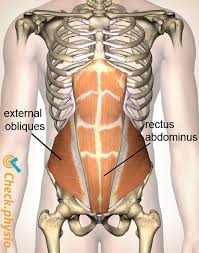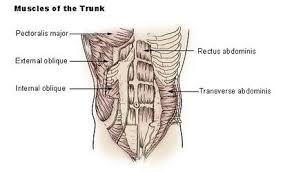

Abdominal muscles cover the anterior and lateral abdominal region: they meet at the anterior midline.
These muscles of the anterolateral abdominal wall can be divided into four groups: the external obliques, the internal obliques, the transversus abdominis, and the rectus abdominis.
There are three flat skeletal muscles in the antero-lateral wall of the abdomen.
The external oblique, closest to the surface, extend inferiorly and medially.
Perpendicular to it is the intermediate internal oblique.
The deep muscle, the transversus abdominis, is arranged transversely around the abdomen.
This arrangement of three bands of muscles in different orientations allows various movements and rotations of the trunk.
The three layers of muscle also protect the internal abdominal organs in an area where there is no bone.
The linea alba is a white, fibrous band that is made of the bilateral rectus sheaths that join at the anterior midline of the body.
The rectal heaths enclose the rectus abdominis muscles-a pair of long, linear muscles, commonly called the “sit-up” muscles.
The linea alba originates at the pubic crest and pubic symphysis, and extend the length of the body’s trunk.
Each abdominal muscle is segmented by three transverse bands of collagen fibers called tendinous intersections, providing the look of six-pack abs, as each segment hypertrophies on individuals at the gym who do many sit-ups.
The posterior abdominal wall is formed by the lumbar vertebrae, parts of the ilia of the hip bones, psoas major and iliacus muscles, and quadratus lumborum muscle.
The posterior abdominal wall plays a key role in stabilizing the rest of the body and maintaining posture.
